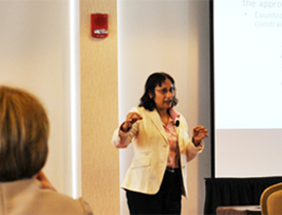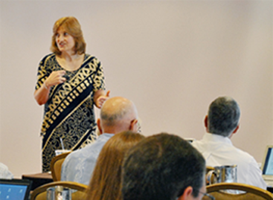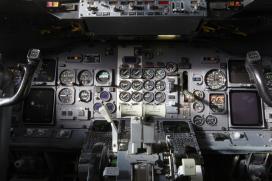Implementing New Aviation Technology
Bringing new aviation technologies to market and ensuring that these technologies are implemented safely and easily poses significant challenges for both industry and government. The United States operates more than 300 domestic airlines, each with its own fleet and legacy systems. The air traffic control system includes hundreds of staffed facilities and thousands of employees all over the U.S. Pilots need to be trained in new technologies to operate their planes safely. The multiple stakeholders involved in a well-run national airspace make the technology integration process a complex undertaking.
This is where Volpe steps in.
In August, more than 100 representatives from the airline industry and government gathered for the Air Transport Association's communications and navigation information exchange. Hosted for the third year by Volpe, The National Transportation Systems Center, in Cambridge, Massachusetts, participants from across the U.S. and abroad engaged in topics ranging from the technical—for instance, the human factors considerations of data communications technologies—to the broad—including the status for Japan's air traffic management system. Industry participants such as JetBlue, United Airlines, and FedEx engaged in frank discussions about the challenges involved in implementing innovative new technologies that will have impacts on aviation safety and efficiency. Volpe staff was on hand to facilitate discussions.
 Volpe technical experts Drs. Divya Chandra and Kim Cardosi also presented on their human factors research during this exchange. Dr. Chandra (at left, speaking at the ATA conference, Volpe photo), a pre-eminent expert on flight deck technology design and evaluation, presented on her most recent research with aeronautical chart formatting to alleviate cognitive load on pilots. She and other staff at Volpe are working to develop guidelines to lessen the procedural complexity of tasks, such as checking in with air traffic control. This research, like her work in the past, will impact international standards.
Volpe technical experts Drs. Divya Chandra and Kim Cardosi also presented on their human factors research during this exchange. Dr. Chandra (at left, speaking at the ATA conference, Volpe photo), a pre-eminent expert on flight deck technology design and evaluation, presented on her most recent research with aeronautical chart formatting to alleviate cognitive load on pilots. She and other staff at Volpe are working to develop guidelines to lessen the procedural complexity of tasks, such as checking in with air traffic control. This research, like her work in the past, will impact international standards.
Dr. Cardosi, a national expert in aviation human factors, presented on the human factors considerations for data communications, the text-based communication system that is being rolled out with NextGen. She is working on developing procedures and system design guidelines to mitigate pilot and air traffic controller errors. This involves working with pilots and controllers, both domestically and internationally, to improve current data communications and enable future NextGen applications to succeed globally.

We help represent the users—pilots and controllers—in the design of the system, but we also help protect the users from themselves by designing safety nets in the equipment and procedures to minimize the chances of human error, and help to prevent human error—some of which is inevitable—from propagating through the system and resulting in an adverse event," said Dr. Cardosi (at left, speaking at the ATA information exchange, Volpe photo).
Air traffic controllers, pilots, industry, government, and other key stakeholders must work together to ensure the safe implementation of new technologies in the world's largest national airspace. In a system with so many players, frank and open exchange of information is of the utmost importance. Drs. Cardosi, Chandra, and other Volpe staff are continually working to engage stakeholders across the system, ensuring that innovations materialize into safe, smart, sustainable technologies.
Drs. Cardosi's and Chandra's recent work:
- Human factors research on performance-based navigation instrument procedures for NextGen, Digital Avionics System Conferences, October 2012.
- Evaluating a de-cluttering technique for NextGen RNAV and RNP charts, Digital Avionics System Conference, October 2012.
- Similar Call Signs presentation at Partnership for Safety Meeting, 2010.
- Runway Safety in the Air Traffic Control Quarterly, February 2010.

